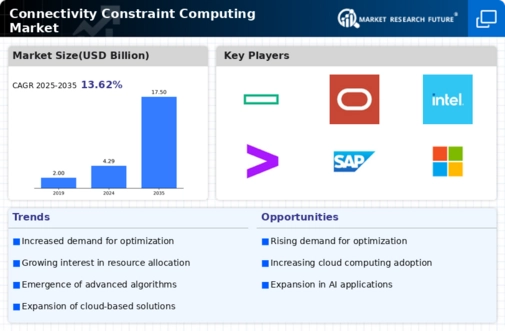Advancements in Network Infrastructure
The Connectivity Constraint Computing Market is significantly influenced by advancements in network infrastructure. The rollout of 5G technology is transforming connectivity paradigms, enabling faster data transmission and lower latency. This technological evolution is expected to enhance the performance of connectivity constraint computing applications, particularly in sectors such as autonomous vehicles and smart cities. With 5G networks projected to cover over 40% of the population by 2025, the potential for real-time data processing and analytics is immense. Enhanced network capabilities facilitate the deployment of more sophisticated computing solutions, thereby expanding the market landscape. As organizations leverage these advancements, the Connectivity Constraint Computing Market is poised for substantial growth.
Rising Demand for Edge Computing Solutions
The Connectivity Constraint Computing Market is experiencing a notable surge in demand for edge computing solutions. As organizations increasingly seek to process data closer to the source, the need for efficient connectivity constraint computing becomes paramount. This trend is driven by the proliferation of Internet of Things (IoT) devices, which are expected to reach over 75 billion by 2025. The ability to analyze data in real-time at the edge reduces latency and enhances decision-making capabilities. Consequently, businesses are investing in edge computing infrastructure, which is projected to grow at a compound annual growth rate of 30% over the next five years. This shift towards decentralized computing architectures is likely to redefine operational efficiencies across various sectors, thereby propelling the Connectivity Constraint Computing Market forward.
Increased Focus on Data Privacy and Security
In the Connectivity Constraint Computing Market, there is an escalating emphasis on data privacy and security. As data breaches and cyber threats become more prevalent, organizations are compelled to adopt computing solutions that prioritize secure data handling. This trend is particularly relevant in sectors such as finance and healthcare, where sensitive information is processed. The market for data security solutions is anticipated to reach USD 300 billion by 2026, indicating a robust investment in secure computing frameworks. Connectivity constraint computing offers a unique advantage by enabling localized data processing, which minimizes exposure to external threats. As regulatory requirements tighten, the demand for secure computing solutions is likely to drive growth in the Connectivity Constraint Computing Market.
Emergence of Smart Cities and IoT Applications
The Connectivity Constraint Computing Market is witnessing a transformative shift due to the emergence of smart cities and IoT applications. Urbanization trends indicate that by 2025, nearly 68% of the world population will reside in urban areas, necessitating innovative solutions for efficient resource management. Connectivity constraint computing plays a crucial role in enabling real-time data processing for smart infrastructure, traffic management, and energy efficiency. The market for smart city technologies is projected to exceed USD 1 trillion by 2025, highlighting the vast opportunities for connectivity constraint computing solutions. As cities adopt these technologies, the demand for efficient computing frameworks is likely to escalate, further driving the Connectivity Constraint Computing Market.
Growing Interest in Sustainable Computing Solutions
Sustainability is becoming a central theme in the Connectivity Constraint Computing Market. Organizations are increasingly recognizing the environmental impact of their computing practices and are seeking sustainable solutions. The market for green computing technologies is expected to grow at a rate of 25% annually, reflecting a shift towards energy-efficient computing. Connectivity constraint computing offers a pathway to reduce energy consumption by optimizing data processing and minimizing resource usage. As businesses strive to meet sustainability goals, the adoption of eco-friendly computing solutions is likely to gain momentum. This trend not only aligns with corporate social responsibility initiatives but also enhances the overall appeal of the Connectivity Constraint Computing Market.

















Leave a Comment